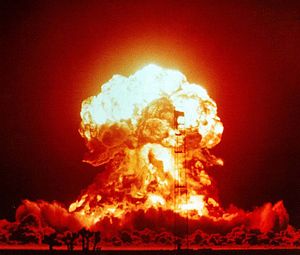Is China considering a change to its nuclear weapons posture that could threaten global strategic stability? Gregory Kulacki with the Union of Concerned Scientists (UCS) thinks so. In a recently published report, Kulacki highlights internal military discourse within the People’s Liberation Army that suggests China may be considering putting its nuclear forces on alert. The full report [PDF] summarizes the context of the discourse on this issue within China and offers evidence suggesting that this idea is under serious consideration. (Kulacki’s UCS colleague Elliot Negin has a helpful post at the Huffington Post examining some of the ramifications of a Chinese shift in posture.)
In short, China has a fairly modest strategic nuclear weapons arsenal and it has historically sought to position itself to assure nuclear retaliation against an opponent for any first nuclear strike against its territory. According to the Stockholm International Peace Research Institute’s January 2015 estimates, China possesses a total inventory of just 260 warheads–a paltry sum compared to the 7,500 and 7,260 Russia and the United States respectively possess. (Each country has over a thousand warheads deployed.)
What’s important in China’s case is that the country has historically not placed its nuclear forces on “high alert.” Nuclear weapons on alert are mated with their delivery vehicles–usually intercontinental ballistic missiles for strategic deterrence–are ready to fire with fewer triggering events. For instance, during the Cold War, mutually assured destruction (MAD) famously held because the United States and the Soviet Union knew that should either of them receive early warning of a nuclear launch, they could in minutes offer strategic retaliation.
Kulacki explains why China never quite got around to placing its nuclear weapons on alert and the reasons have less to do with it feeling that it didn’t have to:
First, the PLA is worried that it doesn’t have a credible nuclear retaliatory counterweight to highly accurate U.S. nuclear weapons, conventional weapons, and missile defense systems. Second, U.S. officials have refused to acknowledge that the United States is vulnerable to a Chinese retaliatory strike, which the Chinese think means the United States is not deterred from attacking them. And third, the United States has threatened China with a nuclear attack a number of times and still refuses to adopt a no-first-use policy. All that makes the PLA very nervous.
It’s unclear if the recent creation of China’s People’s Liberation Army Rocket Force (PLARF) suggests that a shift to a high alert nuclear force is more likely or, indeed, that it is a fait accompli and already in place without public notification (a highly dangerous idea and unlikely for now). It is clear that changes are afoot for China’s nuclear forces. For example, as my colleague Franz-Stefan Gady noted recently, China is upgrading its older ICBMs with multiple, independently retargetable reentry vehicles (MIRVs), a destabilizing modifier to its existing nuclear forces. Moreover, China has been testing hypersonic launch vehicles capable of delivering nuclear strikes, another highly destabilizing innovation for strategic stability.
Interestingly, China’s 2015 Defense White Paper explicitly affirmed its no-first use policy and highlighted that its nuclear weapons were position solely for “strategic deterrence and nuclear counterattack.” Interestingly, as Tong Zhao noted in The Diplomat last year, the White Paper, for the first time, explicitly notes that Beijing was interested in improving its “strategic early warning” for its nuclear forces. Improving its early warning capabilities would certainly suggest that Beijing may be moving toward a highly alert and rapid response capable nuclear force.
If Kulacki’s finding reflect a shifting tide within China, it is clear that the United States needs to engage China on this issue, lest Beijing push on with its plans to shift to an early warning-dependent high alert nuclear force. Bilateral negotiations are one approach, as Kulacki highlights, but the other–“nuclear option” so to speak–is for the United States to take its own nuclear forces off high alert. Washington hasn’t to date made engaging China on this topic a priority, but as U.S.-China relations continue to grow more complicated year after year, expect to hear more about China’s shifting thinking about its own nuclear posture.

































